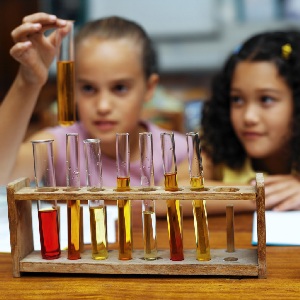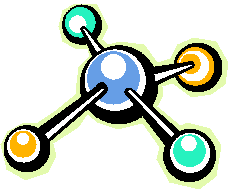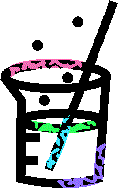Mind-blowing Kids Science Games & Experiments.
“Junior Scientists…Big Inventions!”
“Eureka! Kids science games and experiments are here to entice the Jacks & Jills with its mystical principles and magical theories. So folks, grab your thinking hats and wear you lab aprons b’coz here we go…”
Science is the most amazing, interesting and path breaking subject among all the others.
Why path breaking? Well, because from the smallest of the actions to the biggest of the consequences, all have a scientific logic behind them. Literally, nothing in this universe can run without a scientific theory behind it.

Our kids, at this tender age, notice numerous new things happening around them on a daily basis and therefore, it is obvious that their curious minds are always brimming with questions. Where, What, Why & How - are the first words that pop up in their brain wherever they observe something new.
Strong basics lay solid foundations, upon which any skyscraper of goals, vision, dreams and inventions can be built. Keeping this fact in mind let’s take our kids through this fun and learning course of Kids Science Games and groom them into a great and genius person they can become in the times to come.

Floating Egg
Age Group: 8-12 years
Game Objective: This kids science game demonstrates how the density of a fluid affects its physical properties.
Game Learning: Fluid density.
Materials Required:
- A glass of water.
- Some salt.
- A hard-boiled egg.
How to Experiment:
- For this kids science game first take a glass half filled with drinking water.
- Add 5 tablespoon full of salt into it and mix thoroughly.
- Now, very gently fill the remaining half of the glass with normal drinking water again taking care that it does not mix with the existing salty water.
- Once this is done, carefully slide a hard-boiled egg into the glass.
- Be amazed to see the egg floating in the middle of the glass.
Behind the Scene:
The underlying principle of this science experiment is Fluid Density. The density of the salty water is more than the density of the normal water hence it allows an object to float over it.
When we slide the hard-boiled egg into the glass, the plain water on the top half being less denser allows the egg to sink into it but as soon as the egg reaches the level of salty water, which has a very high density, it starts to float over it therefore leaving an impression that the egg is magically suspended in the middle of the glass.

Magic Boat
Age Group: 5-12 years
Game Objective: This kids science game will demonstrate the effect of fluid surface tension on a object.
Game Learning: Fluid surface tension.
Materials Required:
- A small index card.
- Liquid soap.
- A bucket full of water.
- A paper punch.
How to Experiment:
- Take a small index card of 2”x2” size.
- Punch a hole at the center-rear end of the card.
- Take a bucket full of water.
- Float it gently on the surface of water.
- Now, carefully put a drop of liquid soap into the hole punched on the card.
- Notice what happens! The card automatically pushes itself forward onto the water like a boat.
Behind the Scene:
The underlying principle of this science experiment is Surface Tension.
When the index card is floating on the water a surface tension is created on the entire face of the card that is in contact with water. Now, when a drop of liquid soap is added into the hole that surface tension begins to decrease rapidly and the water molecules start separating from the bottom face of the card thus making the card move forward on its own.

Water & Oil
Age Group: 5-12 years
Game Objective: This kids science game will demonstrates why Oil does not mix with water.
Game Learning: Fluid Mixture, Emulsion and Molecular structure
Materials Required:
- Some Cooking Oil.
- A glass of water.
- Detergent powder.
- Any water soluble color.
How to Experiment:
- For this kids science game first of all take a glass filled half with water.
- Mix some color in it.
- Add 3-4 tablespoon full of oil into it.
- Mix vigorously and leave the solution to settle down.
- Notice how oil separates itself from water and starts floating over the water.
Behind the Scene:
The underlying principle of this science experiment is Molecular Structure of Oil & Water.
Oil and water are like eternal foes, they will never embrace each other!
Reason is their molecular structures. The molecular structure of oil is non polar & hydrophobic (afraid of water) while that of water is polar. Therefore, the molecules of oil will never form a bond with the molecules of water hence, a solution is never formed. Moreover, oil being lower in density as compared to water will always float over it.
My Tip:
Try and add little detergent power into this and mix it again. A new mixture is formed called emulsion.

Magic Bubbles
Age Group: 5-12 years
Game Objective: This kids science game will demonstrate how a bubble can sustain itself for a longer period when certain conditions are met.
Game Learning: Fluid Mixture, Physical properties of water and Molecular structure
Materials Required:
- A large bowl.
- Tape and scissors.
- A card stock paper.
- Two cups of water.
- Two tablespoon full of Glycerin.
- Two tablespoon full of Liquid soap.
- A pencil or a pen.
How to Experiment:
- Make a solution of water, glycerin and liquid soap in a bowl.
- Fold the cardstock paper to form a cone and cut off the protruding edges on both sides to form a perfect round shape.
- Tape the cone firmly so that it remains in shape.
- Dip the bigger end of the cone into the bowl for a few seconds.
- Keeping the cone in vertical position only, gently blow air into the cone from the smaller end till a bubble of substantial size is formed.
- Immediately plug the smaller end with thumb so that the air does not escape back from the bubble.
- Now dip the pencil in the bowl for a few seconds.
- Gently pass the pencil into the bubble.
- Amazing! Bubble…the most delicate and fragile creation in the world does not Blast!
Behind the Scene:
The underlying principle of this science experiment is molecular Structure and physical properties of glycerin and water.
Liquid soap has nothing to do here; it is just added to form bubbles.
Glycerin is highly hygroscopic, which means that it has the ability to absorb water from the atmospheric air. Therefore, the glycerin content on the surface of the bubble does not allow it to burst on its own because it keeps on attracting moisture from air and helps the bubble to sustain itself for a longer time.
Also, when we dip the pencil in the solution a thin film of the mixture is formed around it and when we poke this pencil into the bubble the bubble wall simply flows around it thus preventing it to burst.


Ice Necklace
Age Group: 5-12 years
Game Objective: This kids science game will demonstrate how to form a string of ice cubes using the basic properties of salt and ice.
Game Learning: Freezing temperature of water & Salt properties.
Materials Required:
- A teaspoon full of salt.
- 6 Ice cubes.
- String – one feet length.
How to Experiment:
- For this kids science game first of all arrange all the ice cubes on a table in a straight line.
- Place the string passing through the top-center of all the ice cubes.
- Sprinkle a pinch of salt over each ice cube.
- Leave it for 5-10 seconds.
- Now, slowly lift both the ends of the string and your Ice necklace is ready!
Behind the Scene:
The underlying principle of this science experiment is that the salt lowers the freezing temperature of water.
When we sprinkle salt on an ice cube then due to above mentioned principle the ice cube melts a bit on the top and refreezes again, resulting the string to be bonded with it thus forming our ice necklace.

Volcano
Age Group: 8-12 years.
Game Objective: This kids science game will demonstrate how to form a homemade volcano eruption using house hold ingredients.
Game Learning: Chemical reaction.
Materials Required:
- A small bottle of white vinegar.
- A cup of baking soda.
- A wine glass.
How to Experiment:
- Add some orange or yellow color to the vinegar and mix it well.
- Put a cup of baking soda into the wine glass.
- Now slowly pour the vinegar (premixed with color) into the glass.
- Be astonished to see volcano lava bubbling out of the glass.
Behind the Scene:
The underlying principle of this science experiment is the chemical reaction between vinegar and baking soda.
The acetic acid contained in vinegar reacts with sodium bicarbonate in baking soda to form carbonic acid. As carbonic acid is unstable it immediately breaks into carbon dioxide and water (it's a decomposition reaction). The bubbles we see from the reaction are actually carbon dioxide escaping the solution. Since, Carbon dioxide is heavier than air it flows almost like water when it overflows the wine glass.
What is left in the glass after this reaction is a dilute solution of sodium acetate and water.
My Tip :
For extra effect you can make a realistic looking volcano. It takes some craft skills but it will make your vinegar and baking soda eruptions will look even more impressive!
Take a small empty plastic bottle and mould out a volcanic mountain around it by using clay. Fill the bottle half with baking soda and when your kid is ready for the show…just pour the orange colored vinegar into it.

Blobs
Age Group: 5-12 years.
Game Objective: This kids science game will demonstrate how certain things dissolve and certain things doesn’t dissolve in the water.
Game Learning: Physical properties and molecular structure of Water, Oil and Salt.
Materials Required:
- A glass of water.
- 2 tablespoon full cooking oil.
- Salt sprinkler.
How to Experiment:
- For this kids science game first of all fill the glass up to 60% with water.
- Add 2 tablespoon of oil into it.
- Let it settle down.
- Sprinkle salt over it for 10 seconds and wait.
- You will see blobs of oil sinking into the water and settling down at the bottom.
- After some time those oil blobs disappear by themselves.
Behind the Scene:
The underlying principle of this science experiment is the molecular structure of salt.
Since we know that oil is insoluble in water and being lighter in density it floats on the top. Now, when we sprinkle some salt over this thin oil film, salt being bi-polar in nature clings on to oil molecules and drags it down into the water forming a blob. This blob settles down at the bottom of the glass. After sometime when the salt gets dissolved in water by itself, the oil molecules come back to the surface.


Dancing Water
Age Group: 5 to 12 years.
Game Objective: This kids science game will demonstrate how static electrostatic charges are generated and their effects.
Game Learning: Electrostatic charges.
Materials Required:
How to Experiment:
- Blow a balloon and tighten it firmly.
- Open the bathroom tap such that water flows in a narrow continuous stream.
- Rub the balloon on your head for a few seconds. If it’s winter, rub it on your sweater.
- Bring the balloon near the stream of water slowly.
- Wow! The stream gets bent towards the balloon.
Behind the Scene:
The underlying principle of this science experiment is Electrostatics.
When we rub the balloon on a surface (either on our hair or the sweater) electrostatic charges are developed on its surface and the balloon gets negatively charged. When we bring this balloon near the water stream the positive charges in it gets attracted towards the negatively charged balloon, because opposite charges attract each other, and the water stream bends.

Magic Balloon
Age Group: 5 to 12 years.
Game Objective: This kids science game will demonstrate how air behaves when its temperature changes.
Game Learning: Effect of temperature on any substance (Air in this case).
Materials Required:
- A small balloon.
- An empty glass bottle with a small opening.
- A heater or a bowl of hot water.
How to Experiment:
- For this kids science game first of all stretch a balloon over the mouth of an empty bottle securely. One has to choose a bottle whose opening is neither too large nor too small for the balloon.
- At this stage the balloon will be in completely deflated state.
- Now heat up the outer surface of the bottle either by keeping it in front of a heater or putting it in a bowl of hot water for some time.
- Observe that after some time the balloon gets inflated a bit automatically without any air being blown into it.
Behind the Scene:
The underlying principle of this science experiment is that air expands when its temperature rises.
When we heat up the bottle using any external medium the temperature of the air inside the bottle also raises that results into the expansion of air and hence the balloon automatically inflates a bit.
My Tip!
Did you ever wonder how a hot air balloon flies? Well, now you know the answer!

Magical Water
Age Group: 5 to 12 years.
Game Objective: This kids science game will demonstrate how water travels through a absorbent material and transfers itself from one place to another.
Game Learning: Capillary action of water.
Materials Required:
- A glass full of water.
- An empty glass.
- Any water absorbing material like a thick cotton string or rope (preferably 8-10 mm thick).
How to Experiment:
- Keep a glass filled with water and an empty glass side by side.
- Take a small length of cotton string/rope and dip its one end in the filled glass and other end in the empty one.
- Leave it for half an hour or so and observe how water seeps through the cotton rope/string from the filled glass to the empty glass.
Behind the Scene:
The underlying principle of this science experiment is Capillary action.
Capillary action occurs when the adhesive forces between water molecules and the cotton rope/string is stronger than the cohesive forces between the water molecules itself. Thus, water forms minute passageways (capillaries) through the cotton string/rope and slowly seep through it transferring itself from one glass to the other.

Want to educate your kids about Money? Go through my recommendations and reviews of some of the best Money Games available out there.
Don't miss out on my superb collection of activity based Spelling Games for kids .
Just keep the momentum going and don’t let the enthusiasm seize!
Return From Kids Science Games to Kids Educational Games
Return from Kids Science Games to Kids Games Ideas Home